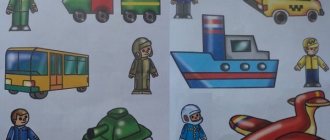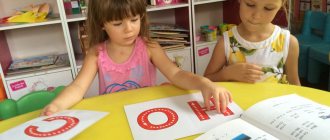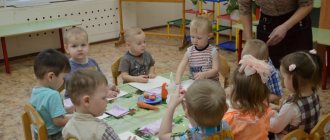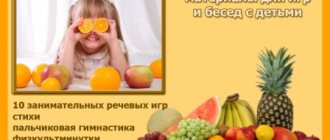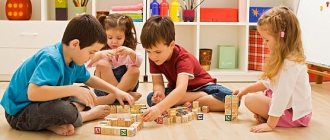Primary school teachers are well aware that young students come to school with completely different levels of preparation. And the better it is, the more confident the child feels in class, and the faster and easier the material is learned. However, you won’t be able to prepare well for school quickly. Even from kindergarten, with the help of games, it is necessary to develop the thinking processes of children, and later, through developmental activities with children already 4-5 years old, you can master the basics of literacy and mathematics.
Any parent can handle the preparation of a future schoolchild; the main thing is to know what knowledge and skills to teach at 4-5 years old, and how to turn home schooling into a “system.”
What tasks are suitable for children 4-5 years old?
In the article: “Organization of developmental activities for children 3-4 years old at home,” it was already written about what a preschool child should know at 4 years old. Now you need to work on the same skills, deepening your knowledge and complicating tasks. A small list of what a baby will learn in the fifth year:
- use of prepositions;
- orientation in space (know left/right, etc.);
- understand where “more”, “equally” or “less”;
- use nouns according to numbers;
- Count to 10, to 5 - in reverse order.
- draw lines without lifting the pencil from the paper, etc.
If your preschooler is already coping with this, don’t stand still and deepen your knowledge. However, all classes should be interesting to him, otherwise excessive workload will only discourage him from studying for a long time.
Developmental aids 4+
Now about the tasks themselves. For children 4 years old you can find many printed publications, the exercises of which will not only help fill the lessons themselves, but will also tell you in which direction to move.
The most popular are the series of manuals by O.N. Zemtsova “Smart Books”, as well as the publication “School of the Seven Dwarfs”. Such textbooks contain tasks for the development of logical thinking, attention, plot pictures, games with stickers, and much more. etc.
An example of an illustration with tasks in mathematics and logic from the “Literacy” series.
For children 4 years old, the first copybooks are also suitable. By tracing simple patterns along the dots, children prepare their hands for writing. An example from the School of the Seven Dwarfs.
Reading ABCs and math books
If the baby is willing to study and is successful, the main subjects - literacy and mathematics - can be studied using real textbooks.
For teaching reading, Zhukova’s “Primer Book” is considered one of the best, which clearly shows how letters merge into syllables, and the methodology itself corresponds to school curricula.
Thematic material:
- Educational board games for children 6 years old
- How to teach a child to read syllables
The Buneevs’ technique is also popular. At the age of four, the authors offer children the guide “On the Road to the ABCs.”
Also, primary school teachers highly value textbooks on mathematics by L.G. Peterson. For preschoolers there is an age-appropriate textbook called “Igrachka”. With it, already at the age of 4, a child will learn all the necessary topics in a playful way.
Tasks in pictures
In addition to manuals, you can use printed pictures with exercises during classes.
Studying right and left
To help your child remember which hand is right and which is left, you can use a poster with palms.
Pictures in which you need to circle the images with the desired direction will also help.
Mathematics
Coloring pages in which you need to connect the dots in order will help you consolidate your knowledge of the number series.
And such mathematical material will teach you how to correlate quantity with number.
Speech development
You can use the pictures to answer questions and write short stories.
Logics
To develop logical thinking, you can prepare the game “Find a Pair”.
Or finish a logical series.
Pictures for a lesson about space
A home lesson can also be thematic. After familiarizing yourself with the topic “Space,” you can offer your child various games to develop thinking processes.
Exercises and games
At four years old, all exercises should be of a playful nature only. Otherwise, the baby will quickly get tired and lose interest in learning.
For example, to develop memory, draw a grid with large cells on paper. Then, together with the baby, place several small toys in square houses. When the child turns away, move the objects to other cells. Invite your preschooler to return them to their places.
The “Book Detective” exercise will help consolidate knowledge of letters and the ability to isolate the first sound in a word. Assignment: guess a letter and ask you to find an object or picture in a book for a given letter. With several children you can play for speed. You can complicate the exercise with a task, find words with two letters or with a letter at the end.
Another game for literacy lessons. Glue cards with letters to objects in the room so that their names begin with that letter. The baby's task is to find which letters are attached incorrectly and correct it.
It’s good when parents are seriously involved in the development and education of their preschool children. However, you should not turn homework into a chore for your child or a chore. The child should enjoy the learning process and look forward to each lesson.
What did I do for the child?
I took a course on the development of children 3–6 years old just in time - now Sophia is at the age when she can have time to apply all the new knowledge in her upbringing. This is important for me as a mother of two children: when my son grows up, the environment for him will be ready. Because now I know exactly what my children need and how to give it to them.
Arranged areas for development
I recognized my daughter's needs and learned to create conditions in which she would enjoy exploring the world around her.
Russian language and reading. I made a tongue zone that would be interesting for the child. Sophia is in the midst of the period when acquaintance with letters occurs most quickly and easily.
I purchased two movable alphabets and a basket with items for sound games. We also have a lot of books and cards to expand your vocabulary.
English language. I really want bilinguals, so I have two options: send my kids to a bilingual kindergarten or teach them myself. I chose the second one.
I rewrote the names of all the songs and poems recommended for children, found old printouts with exercises using the Montessori method from an American website, remembered YouTube, where there are many English-language presentations, and decided that I would gradually start talking to my children. There are basic skills for this.
Sensory development. For anyone who is thinking about how to develop a child at 4.5 years old, arranging an environment for sensory development is one of the main steps. I learned how to do it correctly, and most importantly, I didn’t have to buy anything. It’s easy to do a lot of things with your own hands from things that are in every apartment.
Now my daughter has a lot of activities that help her get acquainted with objects, their shape and properties. I especially liked the idea with the stereognostic bag.
Environment and culture. On the Internet I found a huge number of ideas for studying the world around us with children using Montessori. But this was the difficulty: there was a lot of information, but it was not clear where to start. During the course I learned what, in what sequence and why everything needs to be done.
We have a relief physical globe and a world map in the form of hemispheres. I would like to pay more attention to studying geography, but for now I am sticking to the ready-made plan from the course experts. Then I will improvise if there is a desire.
Mathematics. So far, my daughter hasn’t shown much interest in numbers and counting, but I’m sure she’ll like math baskets and games with cubes. They are already ready, I will offer them as soon as I notice a need.
Creation. We don’t yet have a strictly defined place for creativity. After completing the course, I will be able to assess the scale of the required space and adjust it, taking into account the needs of both children. Now there is an easel and everything necessary for creativity, the child comes up with a lot of things - I just have time to collect and give out materials.
Music. I am far from the world of music. Studying the Montessori method helped to understand how important it is to develop attention to sounds in a child, how it affects rhythmic perception and helps to form melodic and harmonic hearing.
I plan:
- buy colored bells;
- dance to your favorite tracks (now I know how and which ones to emphasize);
- do not use music as background.
Storage of educational toys. We already have three shelves of three or four shelves (for two children), two tables, and an easel.
Set up practical life exercise areas
UPZh are needed not only for the development of everyday skills, but also for the sake of practicing movements. Before I became acquainted with the Montessori method, it was not obvious to me how many different movements a child makes with his arms and legs when performing such exercises.
Personal care. Previously, when thinking about how to develop a 4.5-year-old child at home, for some reason I did not attach importance to the aesthetic component. But the appearance of everything that surrounds a child at home is important.
I am planning in the near future:
- find a beautiful, suitable-sized basket for children for two corners of the bathroom, purchase good products, washcloths that will bring a rich sensory experience and pleasant sensations;
- resolve the issue with toothbrushes and toothpaste;
- pick up the light;
- place a box with disposable soft wipes;
- find a box for jewelry and hairpins;
- bring a headband holder;
- buy additional beautiful combs.
Sophia brushes her teeth and takes a shower on her own.
Now the place with the mirror looks like this.
My daughter enjoys using her jewelry box
Before taking the course, I thought that my child knew how to dress himself. This is true, but much remained unnoticed:
- When clothes are too small or uncomfortable, tantrums happen. I didn’t think that this could or should be corrected somehow. It felt like I got used to hysterics and stopped noticing them. As a result, she revised her eldest daughter’s wardrobe and began to behave with restraint. Now, when a child can’t put something on or take it off, she calmly asks for help. This is our small victory.
- Sophia did not fold her clothes, leaving them lying around inside out. I understood why it shouldn’t be this way, and what the consequences of not completing actions are in the future.
- We didn't sort out our daughter's things. Now I know how important order is: a child is interested in arranging things. In addition, it develops motor skills and coordination.
My daughter has her own drawer for every item.
Development in the kitchen. We removed the doors to open up the kitchen. We are planning to purchase a silicone mat, replace some cutlery, stock up on replacement towels, mittens, and tableware.
We made a separate tap for drinking water - it can be poured into a jug or cup. Wash dishes and hands at a regular sink
Now we set the table before all meals: like for a holiday. And I'm much less tired
Environmental care. I have a big plan for environmental care areas, and it inspires change. There is an understanding of how to introduce a child to everyday life and why it is important to show that he can do everything himself. This is important for the development of a child at 4.5 years old.
This is what the environmental care kit looks like now
We placed the flower in the kitchen, we will soon bring a basket of care products here
Developing speech
Here are some simple but effective exercises that you can do at any time:
- “What happens...” Tell your child the characteristics of an object and ask what happens with such characteristics. Gradually, the task can be complicated by combining several characteristics at the same time.
- “What happens if...” Come up with any plot situations and wonder what will happen in this case.
- "What can be done…". Any object is taken and the question is asked what can be done with it. You can also ask what not to do and why.
- "What and where." Ask your child basic questions. For example, where is the frying pan or TV. Ask to describe all items from any room in as much detail as possible.
- Describe any animal to your baby and ask him to guess. Change roles: let the child try to act as a mystery teller.
- Play onomatopoeia. Pay more attention to problem sounds (usually s, sh, z and r).
IMPORTANT! Be sure to learn poems, songs, fairy tales, and read a lot. Discuss what you saw and heard. The development process must be continuous.
Also read about toys for children's speech development.
Games to develop logical thinking
Logical skills are well used in the following exercises:
- Generalize objects according to any characteristic (for example, find everything round, flat, yellow).
- Determine the similarities and differences between pictures or individual objects.
- Select identical objects from many.
- Assemble the constructor according to the sample.
- Find an extra item and explain your choice.
- Select paired objects, name the characteristic by which the choice was made.
- Find a way out of the maze. Such tasks are found in all children's magazines and educational publications).
Tasks for the development of logical thinking
Logic is a method of thinking in which a person applies acquired knowledge to solve a problem. Older preschoolers are characterized by visual-figurative thinking.
Everything that a child of this age does is focused on practical activity. Kids begin to make connections among phenomena and objects.
Games that develop logic are divided into the following types:
- didactic or desktop-printed. The essence is to find a pair, a match, a grouping based on a common characteristic. These are puzzles, graphic games, sets for composing a sequence;
- developing. This includes games that consist of a number of difficulty levels. They allow you to master skills, practice and improve them;
- speech _ They influence the development of speech and the construction of sentences.
Approximate logical developmental tasks for children 4-5 years old:
- draw on paper a girl whom guests came to congratulate on her birthday. You can find such a drawing on the Internet and print it. Tell the child: “It’s Masha’s birthday. Friends came to congratulate her. Masha holds balloons. How many balloons and candles are there on the cake? What is more, balloons or candles, festive caps on children’s heads or balloons?”;
- find a picture of children playing on the street. Show it to the child and ask how many boys and girls he sees. When describing a picture, you should use the words “one”, “many”, “few”.
Reading and writing
By the fifth year of life, a child already needs to train his hand for further writing at school. The same goes for reading. Simple rules will help with this. These benefits will help develop the child’s hand muscles and prepare them for further writing. You need to start with the simplest elements - tracing patterns and connecting dots. And only after that you can move on to independent writing.
The perception of the first sound in a word is necessarily worked out. To do this, you can glue letters to any objects in the house. The child’s task is to guess whether the card with the letter is chosen correctly.
REFERENCE! In this matter, Zhukova’s primer will be a good assistant for parents. It describes in detail the sound fusion algorithm and other recommendations for adults.
Musicality, sensory and movement
Any preschooler needs to move a lot. Movement helps strengthen the skeleton and muscles, improves agility, coordination, and endurance. Therefore, a child’s life should include gymnastics, exercises, dancing, any outdoor games, as well as cycling.
If you accompany physical exercises with music, this will promote the development of musicality. To develop a preschooler’s sensory perception, he needs to be given the opportunity to touch various textures and materials.
It is necessary to strive to improve fine motor skills, which will improve speech, thinking, logic and memory. Any games with small objects, including finger games, are well suited.
Development of attention
In order for a preschooler to be able to easily switch from one type of activity to another, concentrate his attention on work for a long time and not get tired, attention also needs to be regularly developed.
Game options:
- Find changes in the appearance of the adult and in the arrangement of objects.
- All kinds of variations of the game “edible-inedible” (shoes are not shoes, speaks - does not speak).
- Find the differences in two pictures.
- Game "Trailers". The mother names the object, the child repeats and adds his own, the mother now repeats two objects and adds a third. And so on until someone makes a mistake.
- While walking near the house, you need to remember as many details as possible, and the next day discuss what has changed in the environment.
- With your eyes closed, describe what and exactly where it is in the room.
